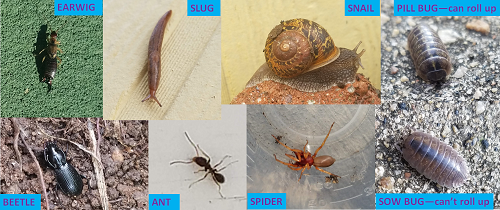
Here are some simple and fun activities that you can do to learn more about nature, the biology of woodlice, and practice of science.
Woodlice like to live in cool and moist habitats. They eat fallen dead leaves and need a place to hide during the day when it is too hot and dry. In the daytime that means you are likely to find them only if you turn over rocks and wood debris.
Look around your yard or a park for places you think they might live and see if you can find them there. Count the numbers you find and see if you can figure out the factors that determine the quality of each of the locations (more roly polies = better habitat). Test out your predictions in a new habitat, like the school yard, a park, or a friend's house. Make sure to check places you don't think they will be to confirm your observations.
What plants and animals are found in our very own schoolyard? How does the environment and the life found there change over the year? This is the kind of work that ecologists do, including us at the RPRP. Your class can do it yourselves with very few supplies, following the guidelines here: Schoolyard Quadrat Investigation. This simple project was developed by the Monterey Bay Aquarium and provides all the info and resources needed.
Some of the animals you may find include:

Citizen Science is the idea that everyday people can contribute to extending real scientific knowledge. Scientists set up projects that people can help them accomplish and make information available through web sites to publicize the opportunity.
A great way to get started is to visit iNaturalist web page and/or download the app to your smart phone. Take a picture of something you see and post it to your account. The app will give you suggestions for what the plant or animal (or fungus) is, but if you don't know for sure that is fine! Other users will look at your picture and suggest identifications for you. Once the ID is made, your observation will become Research Grade--which means scientists may use it to document the location of the species in their research projects.
If you are interested in finding other projects to participate in, visit Zooniverse or SciStarter and use the project finder/search pages to explore projects.
Are you working on a Science Fair Project for school? Cool! Consider doing your project on roly polies. They are easy to find and care for and have interesting behavior. Browse some of our experiments on these pages to find inspiration. If you need help, contact us! The Roly Poly Research Project and Grossmont College Science Club students are available for friendly advice and support. Email Prof. Ripley to be put into contact with resources.

8800 Grossmont College Drive
El Cajon, California 92020
619-644-7000
Accessibility
Social Media Accounts